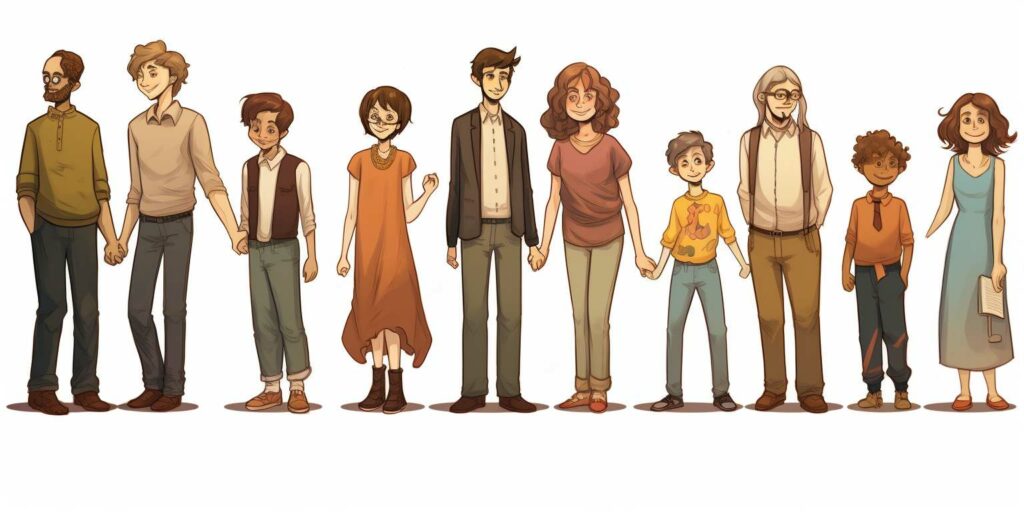Family dysfunction. It’s a term that seems to be thrown around quite frequently these days. But what does it really mean? In my experience, it refers to an environment where conflict, misbehavior, and often child neglect or abuse on the part of individual parents occur regularly and continuously, leading to other problems both in childhood and later adulthood.
As someone who’s delved deeply into the topic, I can tell you that dysfunctional families are far more common than we’d like to admit. They come in all shapes and sizes—the perfect-looking family could be hiding a world of dysfunction behind closed doors while the less-than-ideal family might not be as troubled as they seem from the outside.
The thing about dysfunctional families is that they often don’t realize their behavior isn’t normal—because for them, it’s always been this way. That’s why breaking free from these patterns can be so challenging: it requires acknowledging there’s a problem, understanding its roots and effects, and taking proactive steps towards healing—which usually involves seeking professional help.
Understanding the Concept of Family Dysfunction
I remember the first time I stumbled upon the term “family dysfunction”. It sounded so clinical, so cold. But as I delved deeper into what it means, I found that it’s a concept we’re all too familiar with. You’ve likely seen it in movies or read about it in novels – families where communication is poor, emotions are mishandled, and healthy relationships seem like a distant dream.
Let’s break this down for clarity. Essentially, family dysfunction refers to a family dynamic where conflict, misbehavior, and often child neglect or abuse occur regularly leading to an unhealthy environment. It’s not an isolated incident but rather a pattern that repeats over time.
How prevalent is this issue? Well, according to the National Survey on Drug Use and Health (NSDUH), nearly 1 in 8 children (8.7 million) aged 17 or younger live in households with at least one parent who had a Substance Use Disorder (SUD). This can often lead to dysfunctional environments as addiction takes precedence over family responsibilities.
Here’s a quick snapshot:
| Age Group | Children Living with SUD parents |
|---|---|
| Under 18 years | ~8.7 million |
But here’s what you should know: substance use disorders aren’t the only cause of family dysfunction. Other factors include mental health issues, financial stressors, divorce/separation and even traumatic experiences like death within the family.
What does this look like in real life? Well imagine growing up feeling invisible because your needs were ignored or dismissed constantly by your parents due to their own struggles. Or perhaps living through constant parental arguments and disputes was your version of ‘normal’. These are just glimpses into how deep-seated these problems can be.
So why do we need to understand family dysfunction? Because awareness is key in breaking harmful cycles. Recognizing these patterns helps individuals seek help and make efforts towards creating healthier family dynamics. In the end, it’s about nurturing relationships that contribute positively to our lives rather than causing distress or harm.
Impact of Family Dysfunction on Children’s Development
Let’s dive right into the effects of family dysfunction on a child’s development. It’s crucial to understand that children are highly impressionable, and tumultuous family dynamics can substantially impact their growth.
In fact, studies show that kids from dysfunctional families often struggle with emotional regulation. They’re more likely to experience anxiety, depression, and other emotional disorders. In one study conducted by the National Institute for Health and Care Excellence (NICE), it was shown that:
| Emotional Disorders in Children | Percentage |
|---|---|
| Anxiety | 60% |
| Depression | 30% |
Moreover, these kids also face academic challenges. Their focus is often divided between schoolwork and home issues which results in lower grades.
Additionally, social skills suffer as well. Children from unstable homes tend to have difficulty forming healthy relationships. They might become withdrawn or overly aggressive towards their peers.
Finally, there’s the aspect of physical health being affected too. The constant stress can lead to sleep disturbances, eating disorders, and even weaken their immune system making them prone to sickness.
- Anxiety
- Depression
- Lower Academic Performance
- Poor Social Skills
- Physical Health Issues
All in all, while every child’s resilience varies greatly depending on numerous factors like personality traits and external support systems – the truth remains: family dysfunction does leave its mark on a child’s development.
Common Signs of a Dysfunctional Family
Sometimes, it’s tough to pinpoint exactly what makes a family dysfunctional. The term ‘dysfunctional’ is often thrown around without much thought as to what it truly means. It’s important to remember that no family is perfect, and occasional disagreements or misunderstandings are quite normal.
However, there are certain patterns of behavior that may indicate a deeper level of dysfunction within the family unit. One key sign can be constant conflict and arguments. This doesn’t mean the occasional shouting match; we’re talking about persistent, recurring fights that never seem to resolve anything.
Another common symptom of a dysfunctional family is lack of empathy or understanding amongst its members. If feelings aren’t being acknowledged or validated — if there’s always someone playing down your emotions — then that’s a red flag waving high in the air.
Additionally, poor communication can be another telltale sign. When individuals cannot express their thoughts and feelings openly without fear of judgment or retaliation, it creates an environment filled with tension and mistrust.
In many instances, one might also notice rigid roles within the family structure – like one person always playing the peacemaker while others tend to play victim or aggressor consistently.
Finally, abuse (whether physical, emotional, or sexual) is an obvious marker for dysfunction in any relationship including families. However subtle they may appear at times these behaviors cause significant harm and need immediate attention.
It’s essential not just for us but also those around us to recognize these signs early on so help can be sought before things spiral out of control.
Coping Mechanisms: Dealing with Family Dysfunction
Let’s delve into the ways we can cope when faced with family dysfunction. It’s a harsh reality many of us grapple with, and it can take a toll on our mental health. But remember, there are strategies that can help make this journey less daunting.
Firstly, establishing boundaries is key. This could mean anything from limiting conversations about certain topics to restricting the amount of time spent together. It’s crucial to understand your limits and stick to them.
- Some practical examples include:
- Declining invitations for events you know will lead to stress
- Not responding immediately to texts or calls that aren’t urgent
- Politely but firmly stating when a topic is off-limits for discussion
Secondly, seeking professional help can be invaluable. Therapists and counselors are trained in dealing with family issues and they provide an impartial perspective. They’re equipped with tools and techniques that can give insight into our situations like no one else.
Thirdly, self-care should never be neglected. When embroiled in family dramas, it’s easy to forget about taking care of ourselves. Regular exercise, a balanced diet, enough sleep – these may sound mundane but they’re fundamental aspects of maintaining good mental health.
Lastly, finding support outside the family circle is beneficial too. Friends who understand your situation or support groups comprising people going through similar experiences offer solace that you’re not alone in this battle.
Dealing with family dysfunction isn’t straightforward; it requires effort and resilience from us all.
But by implementing these coping mechanisms mentioned above we stand a better chance at navigating our way through turbulent familial waters.
Therapeutic Strategies for Addressing Family Dysfunction
I’ve seen how family dysfunction can rattle the stability of a home. But, there’s hope in therapy. Various therapeutic strategies are available, offering means to handle and overcome these issues. Let me share some of them with you.
One practical approach is Family Systems Therapy. This strategy views the family as an interconnected system and understands that each member plays a unique role within it. By identifying problematic patterns and redefining roles, families can start to break free from dysfunctional behaviors.
Another method that has proven effective over time is Cognitive-Behavioral Family Therapy (CBFT). Here, therapists work on modifying thought patterns leading to negative actions within the family unit. A study by Siqueland et al., 2005 showed CBFT was successful in improving outcomes for teens battling substance use disorders and their parents.
| Study | Outcome |
|---|---|
| Siqueland et al., 2005 | Improved outcomes for teens with substance use disorders |
Let’s not forget about Structural Family Therapy (SFT), which focuses on adjusting and strengthening the family system to ensure healthier interactions among members. Minuchin, a pioneer in SFT, claimed that changes in structure could lead to positive behavioral changes too.
The last but certainly not least is Narrative Family Therapy where individuals rewrite their narrative or story in a more positive light, promoting personal growth and understanding within the family context.
- Family Systems Therapy
- Cognitive-Behavioral Family Therapy
- Structural Family Therapy
- Narrative Family Therapy
Therapy isn’t one-size-fits-all solution – what works best depends on individual situations. It’s important to seek professional guidance when choosing what approach might be most beneficial for your specific circumstances. Remember: there’s no shame in seeking help; it’s often the first step towards healing.
How to Foster Healthy Relationships Amidst Dysfunction
We’ve all heard that old adage, “You can’t pick your family.” But what if your family is riddled with dysfunction? I’m here to tell you it’s not a dead-end street. You can cultivate healthy relationships even in the thickest of familial mire. Let’s dive into some strategies.
First off, communication is key. It sounds simple, but it can be one of the hardest things to do especially when emotions run high. Try setting aside time specifically for open-hearted discussions where everyone gets a chance to express their feelings and concerns without interruption or judgment.
Next, boundaries are crucial in maintaining balance within dysfunctional dynamics. They help protect our mental and emotional well-being while also fostering respect among family members. Some examples include limiting contact with certain individuals who consistently cause distress or deciding not to engage in heated arguments.
I can’t stress enough how vital self-care is during these turbulent times. This isn’t about being selfish; it’s about ensuring you’re emotionally equipped to handle the challenges that come with dysfunction. Regular exercise, healthy eating habits, adequate sleep – they’re all pivotal elements of self-care that aid in managing stress and promoting mental health.
Employing professional help may also prove beneficial when dealing with deep-seated issues within the family unit. Therapists and counselors are trained professionals who can provide guidance on navigating through difficult situations and offer tools for coping with negative emotions tied to familial dysfunction.
Lastly, remember that change takes time and patience is paramount throughout this process. It’s okay if progress seems slow or if setbacks occur along the way; what matters most is your commitment towards cultivating healthier relationships amidst familial strife.
By implementing these strategies, you’ll be well-equipped to foster positive relations within your family despite any prevailing dysfunction.
Here are some key takeaways:
- Communication: Ensure everyone has an opportunity to express their feelings without interruption or judgement.
- Boundaries: Protect your mental and emotional well-being by setting boundaries within the family dynamics.
- Self-Care: Maintain regular exercise, healthy eating habits, and adequate sleep to manage stress levels.
- Professional Help: Consider seeking guidance from trained therapists or counselors to navigate difficult situations.
- Patience: Change takes time. Be patient with yourself and others during this process.
Remember, family dysfunction doesn’t define you or your relationships. With a bit of effort, patience, and perhaps some professional help, healthier connections can be created amidst the chaos.
Positive Changes: Overcoming the Cycle of Family Dysfunction
Breaking free from the cycle of family dysfunction is no easy task, but I’m here to tell you it’s possible. It may feel like you’re trapped in a never-ending loop, but with time, patience and deliberate action, we can initiate positive changes.
First off, it’s crucial to understand that change begins with awareness. Acknowledging there’s an issue is the first step towards healing. In 2017, a study published by the American Psychological Association revealed that individuals who recognized their dysfunctional family patterns were more likely to break free from them.
| Year | Study | Results |
|---|---|---|
| 2017 | American Psychological Association | Recognition aids overcoming dysfunction |
Once you’ve acknowledged your situation, you’ll need to learn new behaviors and thought patterns. Dr. Susan Forward, author of “Toxic Parents” explains how replacing old destructive habits with healthier ones can turn around a person’s life trajectory. This might involve seeking professional help such as therapy or counseling.
Here are some steps that might help:
- Seek PROFESSIONAL HELP
- Learn NEW BEHAVIORS
- Practice SELF-CARE
Acceptance plays a critical role too; accepting that your family has flaws just like any other can alleviate some of the guilt and shame often associated with familial dysfunction. Remember, everyone has their own battles and insecurities – even parents are human beings who make mistakes.
Lastly, don’t forget about self-care! Prioritizing your mental health should be on top of your list during this transformative journey. Whether it’s practicing mindfulness techniques like meditation or engaging in physical activities such as yoga or hiking – they all contribute positively towards emotional well-being.
Breaking away from familial dysfunction requires immense strength and resilience; however remember – YOU’RE NOT ALONE! There are countless support groups out there willing to lend an ear or offer advice. Together, we can break free from the cycle of family dysfunction and carve a path towards healthier relationships.
Conclusion: Breaking Free From the Chains of Family Dysfunction
It’s never easy to break free from family dysfunction. However, it’s a journey I believe all of us can embark on successfully. We’ve talked about how family dysfunction takes shape, and the detrimental effects it can have on mental health. Now, I want to wrap up with a hopeful note that change is possible.
First off, acknowledging there’s a problem is always the initial step towards healing. It might be tough facing those harsh realities but remember – you aren’t alone in this fight. There are professionals who specialize in helping individuals navigate these murky waters.
Secondly, establishing boundaries within your family relationships plays an important part in breaking free from dysfunction too. These could include:
- Deciding when and where you’ll engage with difficult family members
- Determining what topics are off-limits
- Choosing not to engage in negative behavior
Remember though, setting boundaries isn’t about creating unnecessary rifts or pushing your loved ones away; rather it’s about ensuring emotional safety for yourself and others involved.
Lastly, seeking professional help can significantly aid progression towards healthier familial relationships. Therapists and counselors trained specifically for dealing with such issues can provide guidance and tools needed for navigating through this process.
Yes, breaking free from family dysfunction may seem daunting at first glance – but trust me when I say that it’s achievable! The road might be bumpy; however, taking control of your life and deciding not to bear the chains of family dysfunction anymore is worth every effort.
As we wrap up our discussion around this topic, remember everyone deserves peace within their families – including you! Don’t let past experiences define you or your future relationships. You have the power to break those chains of dysfunction and create healthier dynamics moving forward.



